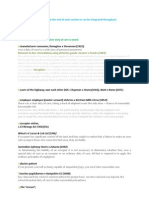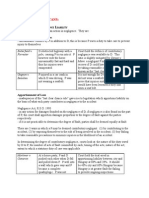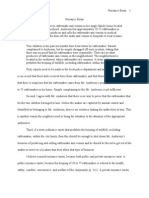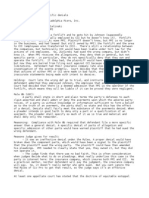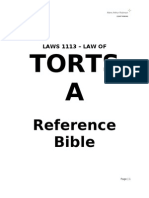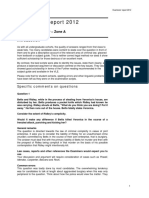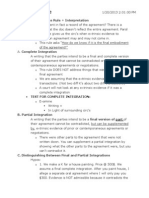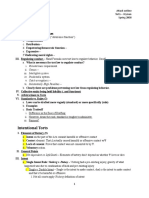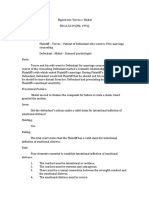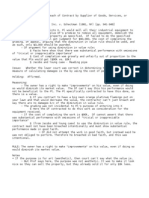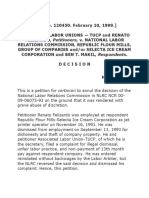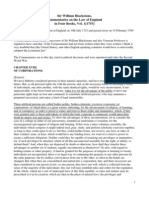Business Law - Tort Notes
Business Law - Tort Notes
Uploaded by
novypooCopyright:
Available Formats
Business Law - Tort Notes
Business Law - Tort Notes
Uploaded by
novypooOriginal Description:
Copyright
Available Formats
Share this document
Did you find this document useful?
Is this content inappropriate?
Copyright:
Available Formats
Business Law - Tort Notes
Business Law - Tort Notes
Uploaded by
novypooCopyright:
Available Formats
11.
TORT
TORT OF NEGLIGENCE NEGLIGENT ACTS
Sue under Tort for injury to Personal Interest (Death or personal injury) or Proprietary Interest (damage to
property)
ECONOMIC LOSSES:
Lord Denning in Spartan Steel v Martin (1972) CA: If defendant, as a result of negligent act, causes actual
physical damage to person or property, that physical damage can be recovered and also any economic loss
truly consequential on the material damage.
Case: Ds employees were digging up a road when they negligently damaged an electric cable supplying
electricity to Ps factory. P were without electricity until the board was able to repair the cable and
immediately the power supply failed, they had to pour molten metal out of their furnace to prevent the
metal solidifying and damaging the furnace. As P could not keep the metal at the correct temperature and
complete the "melt," the metal depreciated in value by 368 and they lost a profit from the sale of the metal
from that melt of 400. They could also have completed four further melts during the power cut and their
loss of profit from those melts was 1,767.
P sued D in negligence and claimed all three sums as damages, a total of 2,535. D admitted negligence and
liability for the physical damage of 368 but denied liability for the plaintiffs economic loss.
3 Essential
Elements
A person can be negligent at law for doing something he should not have done as well as
for not doing something when he should have.
In the law of tort generally, the tortfeasor may not know the plaintiff (contrast w Privity
of K)
In order to succeed in suing under the tort of negligence, 3 elements have to established
1. Duty of Care - Did D owe P a duty of care?
2. Breach of Duty of Care If D breached that duty of care.
3. Resulting damage Did P suffer damage as a result of Ds negligence
1. Duty of Care
Question of
law.
Whether there is a duty of care imposed upon a party to take reasonable care for his acts
and omission is a question of law.
Underlying Principle: The Neighbour Principle Is a duty of care owed, & to whom?
You must take reasonable care to avoid acts or omissions which you can reasonably
foresee would be likely to injure your neighbour. Who, then, in law is my neighbour?
The answer seems to be persons who are so closely and directly affected by my act
that I ought reasonably to have them in contemplation as being so affected when I am
directing my mind to the acts or omissions which are called in question. Mrs Donghue
could neither sue vendor or manufacturer in contract since no contractual nexus.
HL had to determine whether manufacturer owed a duty of care to consumer.
Held: Yes. The manufacturer owed a duty of care to Mrs D (consumer) to take reasonable
care in the manufacture of the drink so as not to injure her.
- Lord Atkin, Donoghue v Stevenson (1932) HL
However, following the ruling passed by the SG Court of Appeal in Spandeck Engineering
(S) Pte Ltd v Defence Science & Technology Agency case in 2007, the implications are
that:
- To establish whether a duty of care exists, a single, universal test comprising
preliminary requirement of factual foreseeability followed by a 2-stage analysis
of proximity and policy will be applied.
- Test applies regardless of whether we are dealing with negligent acts or
omissions or negligent misstatement and whether the interests invaded is
physical injury or property damage or economic loss.
- this is basically a restatement of the two-stage test in Anns & Others v Merton
London Borough Council, tempered by the requirement of factual
foreseeability.
- Once proximity is established, a prima facie duty of care exists.
- [T]his test is to be applied incrementally, in the sense that when applying the
test in each stage, it would be desirable to refer to analogous situations to see
how the courts have reached their conclusions in terms of proximity and/or
policy
1. Preliminary Req: Threshold of Factual foreseeability
It is reasonably foreseeable that Ds carelessness would cause claimant to suffer
injury/damage? i.e. established when it can be shown that the defendant ought
to have known that the claimant would suffer damage from his carelessness.
Factual foreseeability will almost always be satisfied, simply because of its very
nature and the very wide nature of the net it necessarily casts.
Phang J in Sunny Metal case (2007)
2. Proximity
Is there physical proximity or legal proximity or causal (cause and effect)
proximity between P and D? Focuses on the closeness and directness of the
relationship between the parties.
- For Legal proximity use Doctor-Patient, Manufacturer-Consumer,
Driver-Pedestrian kind of terms
- If physical/legal there, there would likely already be requisite proximity
established.
-> Once factual foreseeability and proximity are satisfied, there is a prima
facie duty of care.
-> if there are no policies to negate the duty of care owing to proximate
persons, then there is a duty of care.
3. Policy
Are there relevant policy factors that negate the prima facie duty of care?
- Professions? E.g. doctors, accountants, lawyers.
- Contractual nexus? (if can claim under contract law, then court may not
want to expand on tort of negligence)
- Strength of Bargaining position? (if no contractual nexus, & law does
not provide remedy under negligence, will the plaintiff be able to claim
redress? Judiciary will likely allow claim for economic loss under
negligence: as in RSP Architects v Ocean Front Pte Ltd, where the
property owners have no contractual nexus with the developer, nor can
they sue the Management Corporation Strata Title )
- Floodgates if there is liability in an indeterminate amount for an
indeterminate time to an indeterminate class., courts will most likely
not find a duty of care owing. Cardozo J in Ultramares Corp v Touche
Note: On the other hand, law, far from negating, will hold that there is a duty of care,
whenever there are a spate of events, like the food poisoning cases in Singapore.
2. Breach of
Duty of Care
AFTER ESTABLISHING THAT THERE IS A DUTY OF CARE OWING, WHETHER OR NOT THAT
DUTY IS BREACHED, DEPENDS ON THE STANDARD OF CARE THAT IS OWED. AND THIS
DEPENDS ON WHAT IS THE REASONABLE STANDARD OF CARE IN THE CIRCUMSTANCES.
General Rule - Plaintiff to prove breach of duty, burden of proof lies w P
Exception: res ipsa loquitur (thing speaks so loudly that D must have been negligent)
- Presumption of negligence, unless he convincingly explains that the
injury/damage was not due to his negligence.
- To invoke doctrine, P must show:
- Injury/damage would not have happened, in the ordinary course of
things, but for negligence; and
- thing which caused mischief was under Ds control and management
: Scott v London & St Katherines Docks (1865)
(should advise yr plaintiff to try and invoke res ipsa loquitur)
Test: Whether the standard of care expected from the party who owes the duty is met by
him. A factual enquiry, where it is the omission to do something which a reasonable
man... would do; or doing something which a prudent and reasonable man would not
do. Blyth v Birmingham Waterworks (1856).
Although there is a single duty of care to take reasonable care (I.e. One test), the
standard of care may vary from person to person, and circumstance to circumstance, skill
to skill.
E.g. A driver of a vehicle owes a duty of care to other road users but the standard of care would vary
between a probationary plate driver and one with 30 years of experience.
Thus, to determine whether there is a breach of duty of care, we need to determine
what constitutes reasonable care in a case, and there are several factors the court may
take into account in framing the standard of care.
Guidelines:
1. Seriousness of injury (be careful of physical infirmities of the plaintiff)
The greater the risk of injury, the higher the standard of care is.
In Paris v Stepney Borough Council (1951) HL -
P employee had vision in one eye only. D failed to provide P with safety goggles.
P injured his good eye in the course of work.
Held: D owed P a higher standard of care to one eyed than an employee with
two good eyes.
Risk of injury is a material factor in framing the Standard of Care.
2. Cost of avoiding the harm (Economic argument)
The law does not expect D to take merely reasonable care.
How extensive and costly the measures necessary to eliminate the risk would be
considered in determining the standard of care and, consequently, the breach of
duty.
If cost of avoiding harm is low, standard of care is high.
Latimer v AEC Ltd (1953) HL affirmed CA -
P was employed by D. An exceptionally heavy rainstorm flooded the whole of the
Ds factory. Oil, which normally ran in covered channels in the floor of the
building, rose to the surface and when the water drained away, left an oily film
on the floor. D took measures to clean away the oil, using all the sawdust. P came
on duty with the night shift, unaware of the condition of the floor. While placing
a heavy barrel on a trolley, he slipped on the oily surface, fell on his back, and the
barrel crushed his left ankle.
Held: A reasonable employer had to decide whether or not to shut the factory
down and totally eliminate the risk. The employer took every step that
reasonably could have been taken and had not breached his duty of care.
A defendant does not have to totally eliminate the risk but must do as much as
the reasonable person would do in the circumstances.
3. Likelihood of injury happening
The more likely the harm, the higher the standard of care.
Bolton v Stone (1951) -
P was struck in the head by a ball that flew out of a cricket field across the street
from her home. P sued D, the owner of the cricket field for public nuisance and
common law negligence on the grounds that the field did not have a fence high
enough to prevent balls from flying out of the field. D claimed that only 6-10 balls
had escaped the field in the previous 30 years and it was therefore an
unforeseeable risk.
HL Held: D owed P a duty of care but the risk of a ball escaping the field was so
low that a reasonable person would not have taken further precautions. There
was no breach of duty of care.
4. Level of Skill
Wells v Cooper (1958) CA-
A DIY householder fitted a new door handle so insecurely
That when P pulled the handle he lost his balance, fell and was injured.
Held: The householder was required to show the standard of care, not of a
professional carpenter but that of a reasonably competent carpenter doing such
a trifling domestic job.
D was not liable because he met the standard of the reasonably competent
amateur carpenter.
Law will hinge responsibility commensurate with skill of tortfeasor.
5. Utility Value (Economic Argument)
If the act has high utility value, then it is more likely that is no breach of duty.
E.g. Ambulance trying to save a life, speeds, and knocks down a pedestrian
Low/zero utility value:
E.g. Mischievous acts (climbing walls like spiderman)
The higher the standard of care is framed, the easier it is in law for the defendant to be
in breach.
3. Damages
Causation-in-
fact
&
Remoteness-in-
law
1. Causation-in-fact (identical to contract law)
Is there one causal connection between Ds negligent act/omission factually and the
Injury/damage? Must be an uninterrupted link, if not, in law, there will be no causation-
in-fact.
Thus, even if there is a (i) duty of care, and (ii) you breached it, you will not be liable for it, as you
didnt cause the injury.
Test 1: But-for test - But-for Ds negligence, would P have suffered injury/damage?
If No, Defendants act caused Ps injury/damage (causation)
If yes, Defendants act did not cause Ps injury/damage (no causation)
Barnet v Chelsea & Kensington Hospital (1969) -
P mistook a glass of arsenic for water and drank it. P was rushed to the hospital but the
doctors were negligent and failed to examine him. P was told to go home and died 5
hours later. Ps estate sued the hospital.
Issue: Did Ds negligence cause Ps death?
Held: The hospital owed P a duty of care which they breached.
However, applying the but-for test, the hospitals negligence did not cause Ps death.
Even if P received proper medical treatment, P would have died anyway because of the
lethal consumption of arsenic. D not liable.
(Test 2, sort of.) Novus Actus Interveniens, Breaking the chain of causation
Q When there is a new cause/act, and there are now multiple causes to the injury, But-
For Test (okay for 1-2 causes) will always mean the first author is liable, which cannot be
right. Thus, we have to apply the test laid down by Lord Wright, and look at the
secondary factors.
If Lord Wrights test is positive,
(i) then there is a break in the chain, and the first cause no longer matters, author
not liable, there is no causation-in-fact. OR
(ii) both are liable, but they are held liable in the proportion that they caused the
injury.
Apportionment of Liability:
There can be several tortfeasors who owe the plaintiff respective duties of care
and the judge can apportion liability between each of them, in proportion to
their contribution to the cause of the loss.
Lord Wright in The Oropesa (1943) Novus Actus Interveniens
For a novus actus (a new act) to break the chain of causation,
*I+t must be shown that there is something which I will call
(spontaneous/voluntary/unrelated) ultraneous, something unwarrantable, a new cause
which can be described as either unreasonable or extraneous or extrinsic.
2. Causation-in-law/Remoteness (different from K law) (after establishing causation-in-
fact.
Question of whether, or to what extent, the defendant should have to answer for the
consequences which his breach of duty caused: Sunny Metal Case
I.e. Not all injury or damage suffered is claimable. The law draws a line between those
losses which are recoverable (not too remote) from those which are irrecoverable (too
remote).
Test: Reasonable foreseeability. (The yardstick of the reasonable man)
All losses which are reasonably foreseeable by the defendant are recoverable in law: -
The Wagon Mound (No. 1)
- Not necessary to foresee exact damage.
If P can foresee the type or kind of injury/damage, it does not matter that he
cannot foresee the full extent of the injury/damage; He will be liable for the full
extent: Bradford v Robinson Rentals Ltd (1967) (frostbite not reasonably
foreseeable, but injury from cold weather due to unheated van was, so plaintiff
could claim damages for frostbite)
- Egg-shell Skull rule:
The defendant must take the plaintiff as you find him. If the damage suffered by
the plaintiff is more severe than that which could have been reasonably foreseen
by the defendant, defendant would still be liable for the damage: Lord Parker CJ
in Smith v Leech Brain
Smith v Leech Brain & Co (1962)
P worked as a galvaniser for D. Ps work involved lowering articles by an overhead crane
into a tank containing molten metal. Whilst lowering an article into the tank, he turned
round to see what he was doing, so that his head was outside the shield afforded by the
corrugated iron, and a piece of molten metal struck him on the lower lip, causing a burn.
The burn was the promoting agent of cancer, which developed at the site of the burn,
and from which he died some three years later. The cancer developed in tissues which
already had a pre-malignant condition. But for the burn, cancer might never have
developed, although there was a strong likelihood that it would have done so at some
stage in his life.
Held: D liable for Ps death.
DEFENCES
If plaintiff succeeds in establishing all 3 elements of duty of care, and there is preliminary liability, breach of
duty and resulting damage, then defendant may attempt to shelter behind several defences to avoid
liability.
1. Volenti Non Fit
Injuria
A FULL DEFENCE
FULL DEFENCE.
A person who, with full knowledge and appreciation of the risk, consents to the
injury cannot be heard to complain of the injury.
Volenti is a complete defence and defeats Ps claim entirely.
E.g. consenting to participate in dangerous sports, activities.
E.g. Told you not to do it, you went ahead.
2. Contributory
Negligence
A PARTIAL
DEFENCE
PARTIAL DEFENCE. (Courts almost always use this only, they dont like volenti)
Section 3(1) Contributory Negligence and Personal Injuries Act (Cap 54) states
that D can raise the defence of C/N if he can show that:
- Ps injury was the result partly of Ds own fault and partly of Ps fault and,
- consequently, the damages recoverable shall be reduced to such extent
as the court thinks just and equitable having regard to the Ps share in the
responsibility for the damage:
C/N is apportioned in % terms.
PSYCHIATRIC HARM CASES
P suffers anxiety, distress or psychiatric harm after seeing/witnessing/hearing a scenario which was
negligently caused by D.
No physical injury, no property damage. Can plaintiff succeed in claiming damages under tort of negligence?
Claiming Nervous
Shock
1. Recognisable psychiatric condition?
Grief, sorrow, deprivation or suffering not enough (natural process), This
category of claim is clearly untenable: Singapore High Court in Pang Koi Fa v
Lim Djoe Phing (1993)
2. Primary or secondary victim?
Primary victim is one who personally suffers psychiatric harm because a
defendants negligent act or omission caused an immediate fear of physical injury
to himself.
Secondary victim is one who suffers psychiatric harm as a result of witnessing
injury to others.
SG CA in Ngiam Kong Seng & Anor v Lim Chiew Hock (2008) noted that in
deciding whether there was legal proximity, it is especially important to consider
the 3 elements in McLoughlin v OBrian (1983).
I.e. To recover damages as a secondary victim, must show:
(i) close (legal) tie of love and affection (qn of fact) with the primary
victim; (blood ties generally stronger, can argue for non-blood ties)
(ii) proximity in time and place to the scene of the accident;
(iii) means by which the shock was caused unaided aural and visual (not
through TV) perception of the event or of its immediate aftermath.
Ngiam Kong Seng (2008) CA said that Spandeck test applies in determining duty
of care in psychiatric harm cases.
Negligent
Misstatement (not
Negligent Misrep in
contract) (can claim
financial loss, unlike
negligent acts)
Before 1964, English law was disinclined to allow recovery of financial loss
following reliance on negligent statements.
Not until HL decision in Hedley Byrne v Heller (1964) that the courts held a
plaintiff could claim pure economic loss for negligent misstatements.
SG Court of Appeal in Spandeck Engineering (S) Pte Ltd v Defence Science &
Technology Agency case in 2007, the implications are that:
- This test applies to cases dealing with negligent misstatements,
regardless whether the interests invaded is physical injury or property
damage or economic loss.
- To establish whether a duty of care exists, a single, universal test
comprising preliminary requirement of factual foreseeability followed by
a 2-stage analysis of proximity and policy will be applied.
- Applied incrementally, it would be desirable to refer to analogous
situations to see how the courts have reached their conclusions in terms
of proximity and/or policy
Hedley Byrne v Heller (1964) HL
P, advertising agent, asked their bankers to inquire into the financial stability of a
company, Easipower, with which they were having business dealings. Ps bankers
enquired with the company's bankers (D), and D carelessly gave favourable
references about Easipower but cautioned reference was without
responsibility. P relied on the references and lost 17,000. P sued D for their
careless statements. The action failed because D had expressly disclaimed any
responsibility.
HL Held: To recover for negligent misstatements P must establish that the
statement was made within a relationship where P could reasonably rely on Ds
skill and care in making the statement ('special relationship) which properly
resulted in D undertaking responsibility for the accuracy of the statements made.
No duty of care because of disclaimer.
[Now governed by UCTA s 2(2) must be reasonable to be valid]
Duty of Special relationship as modified by Spandeck (Denniss guidelines)
Factual foreseeability is usually easily satisfied (Note: Mere foreseeability
alone is not enough)
1. Proximity (must satisfy all 4 elements)
(i) Advisor possesses special skill or knowledge (applies to professionals, ppl
who give advice) (Capacity);
(ii) Following the decisions laid down in Caparo and Hedley Byrne, the
Advisor/representor knows/ought to know the advisee/representee
would rely on the advice for the purpose for which the advisor intended;
(Caparo v Dickman: must not be dissonance between the purpose for
which advisor
intended, from the purpose for which the advisee relies on that advice)
2. Policy
(iii) It is reasonable for advisee to rely on the advice, without a second
opinion;
If the court realises that one or more of the three indeterminacies might
apply, the court would be slow to say that reliance on the advice for this
class or classes of potential plaintiffs is reasonable. The court would need
to apply some 'brakes' and determine who could claim from those who
cannot claim. The floodgates argument is always a policy matter. In one
case in England the court allowed the purchasers (mortgagors) to rely on
a bank valuation even though the valuation was not technically meant for
them, as it was common practice for purchasers to do so: Smith v Eric S
Bush
(iv) Advisee suffers financial loss in reliance of the advice. (is the financial loss
mega huge?? to a lot of ppl?)
Caparo v Dickman (1990)
Caparo was a shareholder in a listed company.
It claimed that in reliance of a negligently audited accounts,
it bought more shares in the company and made a successful takeover bid.
The company was actually not doing well financially and Caparo suffered financial
loss as a result.
HL Held: No duty of care was owed to Caparo as an individual shareholder. The
auditors had prepared the accounts for use in
General Meeting of all shareholders. The duty was thus owed to
shareholders in a GM, not to an individual shareholder for making
investment decisions.
Other Torts
Professional negligence Standard of care is in accordance with
Practice accepted as proper by a responsible body of professionals
skilled in that particular profession: Bolam test
Defamation lowering a person in the eyes of rightful
Thinking members of the public. Lander if spoken, libel if written.
Passing Off when a person seeks to passoff his goods or services as those of
another. Eg, the McDonald case against McCurry Restaurant Sdn Bhd (1996)
Inducing breach of contract when a person induces another to
breach his contract with a third party.
Nuisance wrongful interference with the enjoyment of property
(smoke, smell, noise, noxious substances, water seepage)
You might also like
- 25Document49 pages25anon-326319No ratings yet
- Snyder Contracts Fall 2009Document58 pagesSnyder Contracts Fall 2009fvillarroel6No ratings yet
- Answering Criminal Law Problem Questions - Exemplars From Tutorial 1Document8 pagesAnswering Criminal Law Problem Questions - Exemplars From Tutorial 1Kashif AlamNo ratings yet
- NCA Law Remedies Additional CasesDocument8 pagesNCA Law Remedies Additional Casesgen67% (6)
- Torts MapDocument11 pagesTorts MapWade LeesNo ratings yet
- Topic 6 Psychiatric Injury: Question and Answer Zone B 2019Document2 pagesTopic 6 Psychiatric Injury: Question and Answer Zone B 2019Ancellina Chin100% (1)
- Hammontree V JennerDocument3 pagesHammontree V JennerKenzie NothnagelNo ratings yet
- Torts OutlineDocument13 pagesTorts Outlinefashionkate2007No ratings yet
- Professional Responsibility - Morgan - Spring 2006Document33 pagesProfessional Responsibility - Morgan - Spring 2006tyuuNo ratings yet
- Contracts II OutlineDocument16 pagesContracts II OutlineEva CrawfordNo ratings yet
- US V EvangelistaDocument2 pagesUS V Evangelistaalexis_beaNo ratings yet
- Tort Law: Duty of CareDocument22 pagesTort Law: Duty of Carekeerthi99999No ratings yet
- Torts OutlineDocument78 pagesTorts Outlineblair_bartonNo ratings yet
- Defences - Jana's NotesDocument9 pagesDefences - Jana's NotesJana Tenille FlemingNo ratings yet
- Torts - Spring 2000 Professor Turkington Outline Textbook: Cases and Materials On The Law of Torts (3 Ed.), Christie, Meeks, Pryor, SandersDocument46 pagesTorts - Spring 2000 Professor Turkington Outline Textbook: Cases and Materials On The Law of Torts (3 Ed.), Christie, Meeks, Pryor, SandersDane4545No ratings yet
- Remedies EssayDocument17 pagesRemedies EssayTony ZhouNo ratings yet
- Torts Outline NyuDocument64 pagesTorts Outline NyuTony ChenNo ratings yet
- Contracts Outline - WpsDocument55 pagesContracts Outline - WpsrockisagoodNo ratings yet
- O Gorton v. Doty, 1937Document21 pagesO Gorton v. Doty, 1937Chris Miller0% (1)
- Nuisance EssayDocument5 pagesNuisance EssaytveraldibuckNo ratings yet
- Zielinski V Philadelphia Piers, Inc.Document2 pagesZielinski V Philadelphia Piers, Inc.crlstinaaaNo ratings yet
- Torts Outline - Professor Wonnell - Fall 2012Document25 pagesTorts Outline - Professor Wonnell - Fall 2012Joshua SummersNo ratings yet
- Torts Attack Outline MRHDocument22 pagesTorts Attack Outline MRHmattNo ratings yet
- Talmage v. SmithDocument1 pageTalmage v. SmithKhalil Hassan QuinanNo ratings yet
- Contracts Outline KarDocument22 pagesContracts Outline KarchenyijingNo ratings yet
- Contracts Case BriefsDocument28 pagesContracts Case Briefsmaturity88No ratings yet
- Assumption of RiskDocument2 pagesAssumption of RisktripprushNo ratings yet
- Canadian Torts Map and SummariesDocument19 pagesCanadian Torts Map and SummariesJoe McGradeNo ratings yet
- Torts ! Outline - SMUDocument30 pagesTorts ! Outline - SMUVape NationNo ratings yet
- Law of Torts A Semester 1 2008Document99 pagesLaw of Torts A Semester 1 2008valentinejnNo ratings yet
- Twerski Tort Fall 2014Document80 pagesTwerski Tort Fall 2014riku33090No ratings yet
- Examiners' Report 2012: LA1010 Criminal Law - Zone ADocument11 pagesExaminers' Report 2012: LA1010 Criminal Law - Zone AJUNAID FAIZANNo ratings yet
- Chapter 3: Establishing A Claim For Intentional Tort To Person or PropertyDocument7 pagesChapter 3: Establishing A Claim For Intentional Tort To Person or PropertyTina QuinnNo ratings yet
- Torts OutlineDocument82 pagesTorts Outlinecandy920No ratings yet
- CDocument11 pagesCAlexNo ratings yet
- Eckert v. Long Island R.R.Document1 pageEckert v. Long Island R.R.Madison MonzonNo ratings yet
- Contracts OutlineDocument66 pagesContracts OutlinePhraze Nuego100% (2)
- Pennsylvania Railroad v. ChamberlainDocument1 pagePennsylvania Railroad v. Chamberlaincrlstinaaa100% (2)
- OutlineDocument11 pagesOutlinebimmerfreak0No ratings yet
- Ranson v. KitnerDocument1 pageRanson v. KitnerKhalil Hassan QuinanNo ratings yet
- Are Contracts: Contracts I. What Is A Contract? Is There An Agreement?Document38 pagesAre Contracts: Contracts I. What Is A Contract? Is There An Agreement?JoeDelleraNo ratings yet
- Model Answers TortsDocument18 pagesModel Answers TortsBhavin ChandraNo ratings yet
- Civ Pro 1 OutlineDocument35 pagesCiv Pro 1 OutlineSavana DegroatNo ratings yet
- Applicable Law? Formation: I. Agreement RequirementDocument32 pagesApplicable Law? Formation: I. Agreement RequirementeccegeorgeNo ratings yet
- My Torts OutlineDocument35 pagesMy Torts OutlineJohnlouisjohnsonNo ratings yet
- Cheat Sheet TortDocument1 pageCheat Sheet TortP LKNo ratings yet
- Torts - Wyman - Spring 2008Document125 pagesTorts - Wyman - Spring 2008Madison WhiteNo ratings yet
- Remedies Outline #1Document66 pagesRemedies Outline #1hfpmlg100% (2)
- Figueiredo-Torres v. NickelDocument2 pagesFigueiredo-Torres v. Nickelankurpatel96706No ratings yet
- Customary Law Without CustomDocument37 pagesCustomary Law Without CustomhenfaNo ratings yet
- Uffner v. LA Reunion Francaise, 244 F.3d 38, 1st Cir. (2001)Document8 pagesUffner v. LA Reunion Francaise, 244 F.3d 38, 1st Cir. (2001)Scribd Government DocsNo ratings yet
- Are Employers Responsible For Employees' Negligence?Document7 pagesAre Employers Responsible For Employees' Negligence?Jason ItkinNo ratings yet
- American Standard, Inc. v. SchectmanDocument1 pageAmerican Standard, Inc. v. SchectmancrlstinaaaNo ratings yet
- Products Liability Outline-TortsDocument5 pagesProducts Liability Outline-Tortsoceanolive2No ratings yet
- Tort OutlineDocument40 pagesTort Outlinectk05No ratings yet
- PR OutlineDocument58 pagesPR Outlinesrwalker90No ratings yet
- Torts OutlineDocument15 pagesTorts OutlineMichael SantosNo ratings yet
- PL OutlineDocument83 pagesPL OutlinejwwisnerNo ratings yet
- Property Law Spring 2017 Professor Marc H. Greenberg Golden Gate University School of LawDocument6 pagesProperty Law Spring 2017 Professor Marc H. Greenberg Golden Gate University School of LawFacu BernardoNo ratings yet
- Contracts Spring Final HotsheetDocument31 pagesContracts Spring Final HotsheetGenUp SportsNo ratings yet
- People vs. OlvisDocument9 pagesPeople vs. OlvisnellafayericoNo ratings yet
- Upload 3Document11 pagesUpload 3maanyag66850% (1)
- Evidence 2nd SetDocument51 pagesEvidence 2nd SetDanyNo ratings yet
- 1486 Espino vs. People (AQUINO)Document2 pages1486 Espino vs. People (AQUINO)Mitch Tuazon100% (1)
- Testate Estate of The Late Alipio AbadaDocument2 pagesTestate Estate of The Late Alipio AbadaAngelRea100% (1)
- Judge Dadole v. Commission On AuditDocument2 pagesJudge Dadole v. Commission On AuditNoreenesse SantosNo ratings yet
- Refugee Problems in IndiaDocument6 pagesRefugee Problems in IndiaAyush PandiaNo ratings yet
- Property - Presentation 1Document26 pagesProperty - Presentation 1jorgepayasayNo ratings yet
- Effects of PardonDocument1 pageEffects of PardonJassey Jane OrapaNo ratings yet
- Aldemita v. Heirs of SilvaDocument4 pagesAldemita v. Heirs of SilvaJunelyn T. EllaNo ratings yet
- 9) Trademark Assignment DeedDocument7 pages9) Trademark Assignment DeedAnirban DasNo ratings yet
- Appellate Brief Fair v. Obama (Walker)Document42 pagesAppellate Brief Fair v. Obama (Walker)Kenyan BornObama100% (1)
- Yatco & Yatco Solicitor General Edilberto Barot, Solicitor Camilo QuiazonDocument4 pagesYatco & Yatco Solicitor General Edilberto Barot, Solicitor Camilo QuiazonChristian Joe QuimioNo ratings yet
- 4) Capuz V Court of AppealsDocument1 page4) Capuz V Court of AppealsKulit01No ratings yet
- Appeal From Original Decrees PDFDocument18 pagesAppeal From Original Decrees PDFAinam FatimaNo ratings yet
- Warranty LetterDocument2 pagesWarranty LetterRanbir SinghNo ratings yet
- Testate Succession and Estate PlanningDocument29 pagesTestate Succession and Estate PlanningLautechPredegree100% (1)
- Nali v. Whitbeck - Document No. 3Document2 pagesNali v. Whitbeck - Document No. 3Justia.comNo ratings yet
- 16 Subido Vs OzaetaDocument8 pages16 Subido Vs OzaetabchiefulNo ratings yet
- (Sales) Roman Catholic Church Vs Regino PanteDocument2 pages(Sales) Roman Catholic Church Vs Regino PanteWendell Leigh OasanNo ratings yet
- Blackstone's Commentaries - of Corporations - ExtractDocument5 pagesBlackstone's Commentaries - of Corporations - ExtractVanillaSkys100% (3)
- Judgement On Mediation in Cheque Bounce Cases Under Section 138 NI ActDocument89 pagesJudgement On Mediation in Cheque Bounce Cases Under Section 138 NI ActLatest Laws TeamNo ratings yet
- Semester IIIDocument18 pagesSemester IIIdewanibipinNo ratings yet
- MISSMAS vs. Southeast Mindanao Gold Mining Corp., G.R. No. 149638, December 10, 2014Document12 pagesMISSMAS vs. Southeast Mindanao Gold Mining Corp., G.R. No. 149638, December 10, 2014Lou Ann AncaoNo ratings yet
- United States District Court Southern District of Indiana Indianapolis DivisionDocument6 pagesUnited States District Court Southern District of Indiana Indianapolis DivisionRenee CookNo ratings yet
- Ninal v. BayadogDocument2 pagesNinal v. BayadogsabethaNo ratings yet
- BPI-SEC Corp. Vs GuevaraDocument2 pagesBPI-SEC Corp. Vs GuevaraAnonymous 7eXWZLz2No ratings yet
- Peace EssayDocument6 pagesPeace EssayMark Jayson PecasalesNo ratings yet
- 11 - Taguba V de Leon - PEREZDocument2 pages11 - Taguba V de Leon - PEREZPearl asdfNo ratings yet











